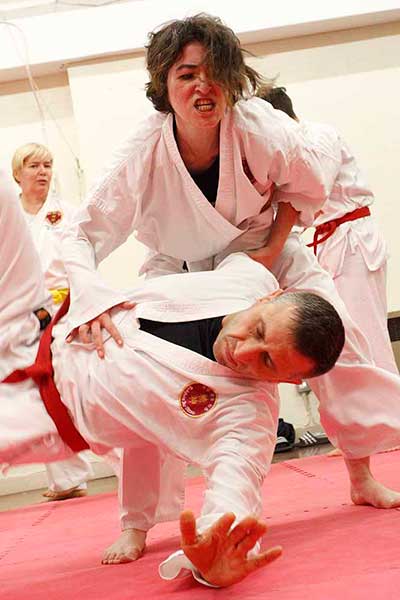Seishin Jiu-Jitsu
Japanese Jiu-Jitsu
What is Japanese Jiu-Jitsu
Japanese Jiu-jitsu also known as Japanese Ju-Jitsu (JJJ) and Ju-Jutsu is one of a plethora of martial art styles available to learn how to defend yourself
It can be difficult for a beginner to know which one to choose, especially when different styles have similar sounding names – for example, BBJ otherwise known as Brazilian Jiu-Jitsu. Unlike most martial arts being taught, true Japanese Jiu-jitsu has no sporting applications – it is quite simply a very effective form of street self-defence.
 Techniques include
Techniques include
- Ground fighting
- Joint-locking
- Choking & Strangulation
- Pinning & Restraining
- Throws & Sweeps
- Break-falling techniques
- Kicking and Punching
- Blocking
- Stances and guard techniques
Japanese Jiu-Jitsu originates from Feudal Japan and was developed through ancient Samurai training to help them fight when they found themselves without a weapon. Many other martial arts incorporate Jiu_Jitsu techniques as part of their arsenal, including Aikido, Krav Maga, Karate, Brazilian Jiu-Jitsu, Judo, MMA, Muay Thai and Kick Boxing
Students will also find themselves learning human anatomy and first aid as part of their journey. More detailed information follows below on Japanese Jiu-Jitsu which will help you decide if it’s for you
Japanese or Brazilian Jiu-Jitsu?
Japanese Jiu-Jitsu is purely self-defence with no rules limiting how you can strike your opponent – Brazilian Jiu-Jitsu is a competitive sport with rules designed to keep the competitors safe.
You can use any of the tactics or techniques that might be illegal in BJJ to take the enemy down and cause major harm like bone breakage and joint dislocation. Specifically, in competitions, there are rules to follow for BJJ practitioners, and they cannot use dirty tactics like gouging eyes and striking the groins like practitioners do in Japanese jujutsu.
BJJ prefers to take people to the ground while Japanese Jujitsu guys do prefer to remain on their feet – a good choice if you are fighting more than one opponent!
Street Self Defence
Japanese Jujutsu techniques are extremely effective in any street fighting scenario.
The art has been developed over hundreds of years and is continually evolving to provide highly practical solutions for self-defence. The opponent’s momentum and strength are used often used against them, making jiu-jitsu ideal for men and women of any size and shape. The art provides the skills necessary to strike your opponent and defend yourself, as well as provide first aid if needed.
Many of the techniques can cause serious and permanent injury to your opponents. Your training teaches you to exercise careful control to prevent lasting injury to an attacker.
Jiu-Jitsu History
Japanese Jujutsu is an ancient martial art developed during feudal times in Japan
It was developed by the samurai to use on the battlefield when they had lost their main weapons or totally disarmed. Jiu-Jitsu continues to evolve with the times and is now regarded as one of the best forms of street self-defence for both men and women
Jujutsu, Ju-Jitsu and Jiu-Jitsu are all the same art. The changes in spelling are due to the different western pronunciations of the original word in Japanese.
The Samurai
Samurai warriors developed Jiu-Jitsu to combat armed opponents in heavy battle armour.
They realised that, if they found themselves unarmed on the battlefield for some reason, there was no in punching and kicking an opponent wearing full body armour.
They introduced a battle-winning system of grappling, locks, throws and takedowns that often used the enemy’s own strength and momentum against them.
Grading System
Most martial arts styles use coloured belts to grade students. This was originally done by the founder of modern judo, Jigoro Kano
Belts are divided into ‘Kyu’ for coloured belts and ‘Dan’ for black belts. In order to be promoted to the next belt, a student must be formally assessed by performing a number of techniques in front of sensei(s)
They may also be asked to show all the techniques from their previous belts – quite a challenge!
